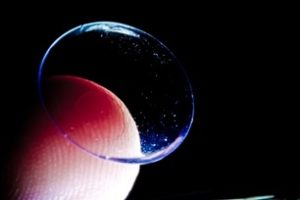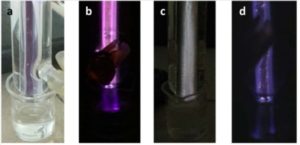Earlier, I wrote a piece about how StellarNet customers are using compact spectrometers to tackle the multi-headed beast that is cancer. While cancer is a large problem, it is but one of many in the healthcare industry. Diseases need to be understood, treatments need to be developed, and more fundamentally, methods and devices need to be created to perform measurements at all steps. Here’s a sampling of the diverse ways that StellarNet customers are creating health-related methods and devices.
Methods

The Matija group at the University of Belgrade has developed a technique called Aquaphotomics to study how water interacts with materials. The researchers used a StellarNet DWARF-Star spectrometer and a transmission fixture to measure the first overtone of water (1300-1600 nm) in hydrogels, used for contact lenses. They performed two interesting experiments: one comparing a low water content hydrogel to a medium water content hydrogel [1], and one looking at worn versus new lenses [2]. In both experiments, performing principle component analysis on the spectra allowed for classification of the materials. It also revealed properties of the materials. For the water content, the low and medium content hydrogels had similar amounts of bound waters, waters hydrogen bonded to the hydrogel molecules. The medium content hydrogel had increased free water content, meaning waters that were not strongly bound to anything. For the worn lenses, wear decreased the number of bound waters, which increased the waters free to bond with the proteins that accompany wear, such as proteins found in tears.
The near IR region can also be used for detecting oxygen in the brain. Rackebrandt and Gehring created a method to measure the  oxygen content of arteries in the brain [3]. Notably, the method is accurate and fast, which current methods have never achieved simultaneously. They created a phantom model that matches the optical properties of the scalp, skull, blood, and brain and collected signal at varying distances from the light source. They used a StellarNet white light source and BLUE-Wave spectrometer to measure a reference spectrum. The spectra from the phantom model matched the reference at several distances from the light source as well as for several skull thicknesses, proving the technique’s suitability for measuring oxygen content.
oxygen content of arteries in the brain [3]. Notably, the method is accurate and fast, which current methods have never achieved simultaneously. They created a phantom model that matches the optical properties of the scalp, skull, blood, and brain and collected signal at varying distances from the light source. They used a StellarNet white light source and BLUE-Wave spectrometer to measure a reference spectrum. The spectra from the phantom model matched the reference at several distances from the light source as well as for several skull thicknesses, proving the technique’s suitability for measuring oxygen content.
Devices
As we saw for cancer, plasma devices are useful for selective targeting. Instead of targeting cancer cells, Wang et. al. targeted Schistosoma japonicum, a parasite that causes schistosomiasis [4]. They found that using oxygen-rich gases to generate plasma could produce a 20% survival rate of the parasite in water after treating for 10 minutes. They used a BLUEWave spectrometer to measure the discharge of the plasma, which included oxygen and nitrogen radicals. Taking pH measurements of the treated water over time confirmed that these species were reacting. The image below shows the plasma device discharging into the sample.

Partial figure from Ref [4], licensed under CC-BY.
Finally, Orlova et. al. sought to make a UV transparent thin film with provitamin D embedded in it [6]. They used a BLACK-Comet to measure the irradiance of the UV light source, allowing the conversion from irradiation time to UV dose. Plotting the film’s absorbance at 282 nm versus dose showed that a polyvinyl butyral film gave good sensitivity at low doses. Because of this, the authors suggested that the film would be useful as a UV dosimeter to help limit a person’s UV exposure.
From measuring water in contact lenses to characterizing the iPhone’s flashlight, StellarNet products are an integral part of medicine and healthcare. Next time you receive treatment for an illness or injury, remember to thank your doctors, of course. But, save a thank you for a spectroscopist, too.
References
1. Munćan J, Mileusnić I, Šakota Rosić J, Vasić-Milovanović A, Matija L. Water Properties of Soft Contact Lenses: A Comparative Near-Infrared Study of Two Hydrogel Materials. Int J Polym Sci. 2016;2016: 1–8.
2. Šakota Rosić J, Munćan J, Mileusnić I, Kosić B, Matija L. Detection of protein deposits using NIR spectroscopy. Soft Mater. 2016;14: 264–271.
3. Rackebrandt K, Gehring H. Detection of the venous oxygen saturation in an oxygenation and perfusion model. Biomed Phys Eng Express. 2016;2: 015013.
4. Wang X-Q, Wang F-P, Chen W, Huang J, Bazaka K, Ostrikov KK. Non-equilibrium plasma prevention of Schistosoma japonicum transmission. Sci Rep. 2016;6: 35353.
5. Petryayeva E, Algar WR. A job for quantum dots: use of a smartphone and 3D-printed accessory for all-in-one excitation and imaging of photoluminescence. Anal Bioanal Chem. 2016;408: 2913–2925.
6. Orlova TN, Terenetskaya IP, Eremenko AM, Surovtseva NI. Provitamin D Doped Silica and Polymeric Films: New Materials for UV Biosensor. MSA. 2010;01: 267–271.

By Debra McCaffrey, PhD
StellarNet Technical Staff Writer
UC Berkeley Chemistry





